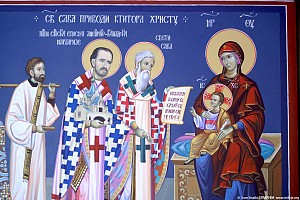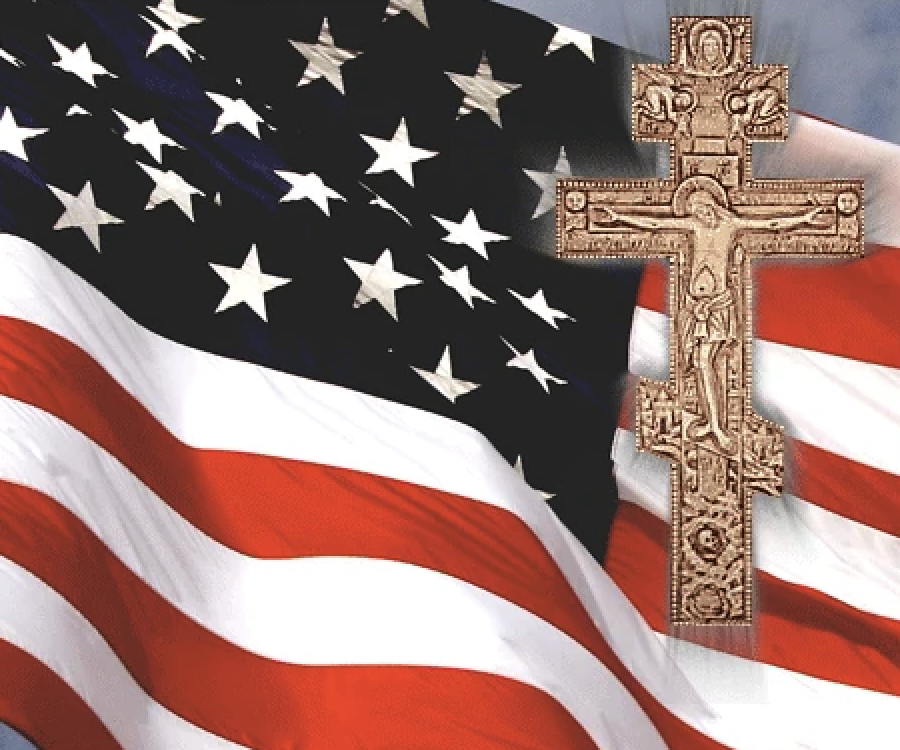The Arrival of Orthodoxy in America
The great Orthodox Christian missionary work that began with Pentecost in Jerusalem centuries earlier finally reached North America in the 18th century. The first Orthodox missionaries arrived with explorers Vitus Bering and Alexei Chirikov, who claimed Alaska and the Aleutian Islands for Russia in 1741. Over the next fifty years, alongside economic and colonial expansion, efforts were made to bring the Orthodox Faith to the native peoples—the Aleuts, Athabascan Indians, Tlingits, and Eskimos.
The First Orthodox Mission to America (1794)
On September 24, 1794, the first formal Orthodox Christian mission arrived in Kodiak, Alaska. This mission consisted of eight monks, two novices, and ten Alaskan natives who had been taken to Russia by Gregory Shelikov in 1786. Upon arrival, they discovered that hundreds of natives had already been introduced to Orthodoxy and baptized by laymen. Shelikov himself had baptized around 200 Aleuts on Kodiak Island.
A Tapestry of Orthodox Traditions in America
Today, when someone identifies as Russian Orthodox, Greek Orthodox, or Serbian Orthodox, it reflects the cultural heritage of their parish’s tradition rather than ethnic exclusivity. Across America, Orthodox churches beautifully blend:
Languages: Services often mix English with Greek, Slavonic, or Arabic
Music: From Byzantine chant to Russian polyphony
Traditions: Unique saints’ day celebrations and fasting practices
The three largest jurisdictions – the Greek Orthodox Archdiocese (GOA), Orthodox Church in America (OCA), and Antiochian Archdiocese (ANT) – work together in smaller communities while maintaining vibrant ethnic parishes in cities. As more Americans embrace Orthodoxy, English has become increasingly common in worship, making the ancient faith accessible to all.
Martyrs of the American Mission
Hieromonk Juvenaly: The First Orthodox Martyr in America
In 1795, Hieromonk Juvenaly left Kodiak to evangelize the Chugach people, baptizing over 700. The following year, he traveled toward Lake Iliamna, where his life was tragically cut short. After baptizing local tribes, he insisted they abandon polygamy and took some children to educate in Kodiak. Regretting their decision, the tribesmen pursued and killed him.
Witnesses later reported a miraculous event: after his death, Juvenaly’s body rose and followed his killers, speaking to them. Terrified, they attacked him repeatedly until they dismembered his body. A column of flame reportedly appeared where his remains lay, marking him as a true martyr for the Faith.
The Martyrdom of the Aleut Peter
In 1865, Simeon Yanovsky recounted the story of fourteen Aleuts captured by Spanish Jesuits in California. The Jesuits demanded they renounce Orthodoxy for Catholicism, torturing one named Peter to force compliance.
Peter endured horrific suffering—his toe and finger joints were severed, then his feet and hands. Despite unbearable pain, he refused to abandon his faith, declaring, “We are Christians and we will not betray our faith!” He died from blood loss, a courageous witness to Orthodoxy.
When St. Herman of Alaska heard this story, he reverently crossed himself and proclaimed, “Holy newly-martyred Peter, pray to God for us!”
St. Herman of Alaska: America’s First Orthodox Saint
Early Life and Missionary Calling
Born in 1756 near Moscow, Herman entered monastic life at 16. After a miraculous healing through the Theotokos, he joined Valaam Monastery, where he embraced missionary work. In 1793, he was sent to Alaska as part of the first Orthodox mission.
Life on Spruce Island
After enduring persecution from the Russian-American Company, Herman retreated to Spruce Island, which he called “New Valaam.” There, he lived as an ascetic, caring for orphans, running a school, and tending a garden. Despite hardships, he radiated joy, saying:
“I am not alone there! God is there, as God is everywhere. The Most-Holy Angels are there. With whom is it better to talk, with people or with Angels? Most certainly with Angels.”
Miracles and Legacy
The natives revered Herman as a holy intercessor. When a tidal wave threatened the island, he placed an icon on the shore, declaring the waters would not rise past it—and they did not. He also protected them from fire through prayer.
Before his death in 1837, Herman prophesied he would be forgotten for 30 years, then remembered. True to his words, he was glorified as a saint in 1970, becoming the first canonized Orthodox saint in America.

St. Innocent of Alaska: Apostle to the Americas
Missionary Labors in Alaska
Born in 1797 in Siberia, John Veniaminov (later St. Innocent) volunteered for the Alaskan mission in 1823. Arriving in Unalaska, he built a church, learned native languages, and translated Scripture. His preaching captivated listeners—one native recalled:
“When he preached the Word of God, all the people listened without moving… Nobody felt hungry or thirsty as long as he was speaking.”
Bishop and Metropolitan
After his wife’s death, he became a monk and was consecrated Bishop of Kamchatka and Alaska in 1840. He expanded the Church’s reach, establishing schools and seminaries. In 1868, he was elevated to Metropolitan of Moscow but never forgot his American flock, founding the Russian Missionary Society to support Orthodox work in Alaska.
Canonized in 1977, St. Innocent is remembered as the “Enlightener of the Aleuts and Apostle to the Americas.”
St. Mardarije of Libertyville: Shepherd of the Serbian Diaspora
Early Life and Calling
Born Ivan Uskoković on November 2, 1889, in the village of Kornet, St. Mardarije was baptized in the small Church of St. George. The deep Orthodox faith of the Russian people, with its majestic services and pious way of life, left a lasting impression on his soul.
Missionary Work in America
Recognizing the need for authentic missionary work among Serbs in North America, the Holy Synod of the Russian Orthodox Church sent Hierodeacon Mardarije to the United States on July 3, 1917. Later that year, he was elevated to archimandrite in Philadelphia.
St. Nikolai (Velimirović) of Ohrid and Žiča, the first administrator of the Serbian Orthodox Church in America and Canada, proposed Archimandrite Mardarije as the first bishop of the American-Canadian Diocese. His life would prove to be one of sacrifice, patriotism, and tireless labor for the faith.
Building a Spiritual Center
In 1923, St. Mardarije returned to America to continue organizing the Serbian Orthodox Diocese. Deeply aware of the need for a spiritual center, he established the temporary diocesan headquarters in Chicago. That same year, he purchased 25 acres of land in Libertyville, Illinois, envisioning a monastery-orphanage.
Despite severe economic hardship and internal struggles within the Serbian diaspora, he persevered. The saying, “He builds the Church while starving to death,” perfectly describes his sacrifice in establishing St. Sava Monastery in Libertyville—now one of the most significant spiritual centers for Orthodox Serbs in America. Today, his holy relics rest in St. Sava Monastery, where countless faithful have received miracles and healing through his intercessions.
St. John Maximovitch: Wonderworker of San Francisco
Exile and Monastic Life
Born in 1896 in pre-Revolutionary Russia, St. John (Maximovitch) fled to Belgrade in 1921 to escape Bolshevik persecution. In 1926, he was tonsured a monk and ordained a priest under the guidance of St. Nikolai Velimirović. Known for his extreme asceticism—he never slept in a bed—St. John inspired seminarians with his devotion to Christ and Holy Russia.
Missionary Bishop
Consecrated bishop in 1934, he shepherded Russian exiles in Shanghai, miraculously preserving an orphanage during war and revolution. When communism spread to China, he led his flock to safety in the Philippines and eventually to America.
In San Francisco, he completed construction of the Joy of All Who Sorrow Cathedral despite opposition. Known as a “holy fool,” he cared deeply for his flock while maintaining strict ascetic practices. He also revived veneration of Western saints from the first millennium, bridging Orthodox traditions.
Miraculous Relics
St. John reposed on July 2, 1966, while traveling with the Kursk Root Icon. His relics now rest in San Francisco’s Holy Virgin Cathedral, where they continue to work miracles of healing for those who approach with faith.
Elder Ephraim of Arizona: Reviver of Athonite Monasticism in America
From Athos to America
Born Ioannis Moraitis in 1928 in Greece, Elder Ephraim became a disciple of St. Joseph the Hesychast on Mount Athos. After his spiritual father’s repose, he revitalized several Athonite monasteries before answering the call to America in 1979.
Monastic Foundations
Beginning with the Nativity of the Theotokos Monastery in Pennsylvania (1989), Elder Ephraim established 19 monasteries across North America. His crowning achievement was St. Anthony’s Monastery in Arizona’s Sonoran Desert (1995), which became a spiritual oasis for thousands.
Through confession and the Jesus Prayer, he guided countless souls to Christ until his repose in 2019. His monasteries continue to be beacons of Orthodox spirituality in America.
The Growth of Orthodoxy in America
After Alaska’s sale to the U.S. in 1867, the Church expanded beyond native missions. In 1891, Bishop Nicholas (Ziorov) ministered to Uniate converts and immigrant communities—Serbs, Greeks, Arabs, and others.
Under St. Tikhon (later Patriarch of Moscow), the Church was reorganized, with its center moved to New York. The first Orthodox bishop consecrated in America, St. Raphael of Brooklyn, served Arab Orthodox communities, while Bishop Innocent (Pustynsky) oversaw Alaska.
Conclusion: A Living Legacy
Orthodoxy in America began with martyrs, missionaries, and saints who braved immense challenges to bring the Faith to new lands. Today, their legacy endures in thriving Orthodox communities across the continent.
From the martyrs Juvenaly and Peter to Sts. Herman, Innocent, Mardarije, John Maximovitch, and Elder Ephraim, their sacrifices remind us that the Gospel’s light shines even in the most distant corners of the earth. Their miraculous relics continue to sanctify America, offering healing and hope to all who approach with faith.
May their prayers strengthen the Orthodox Church in America for generations to come!

